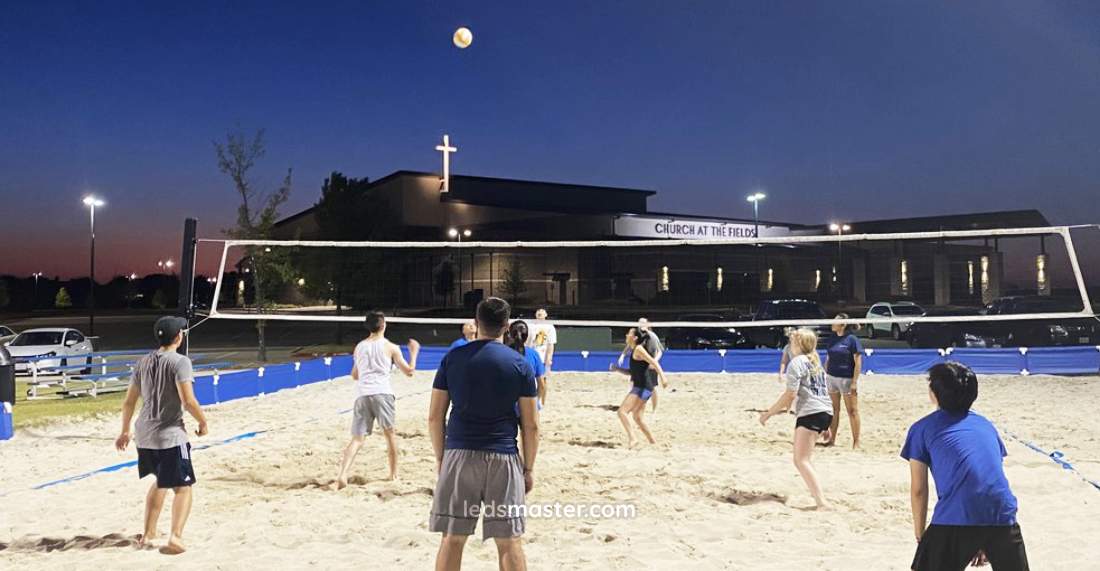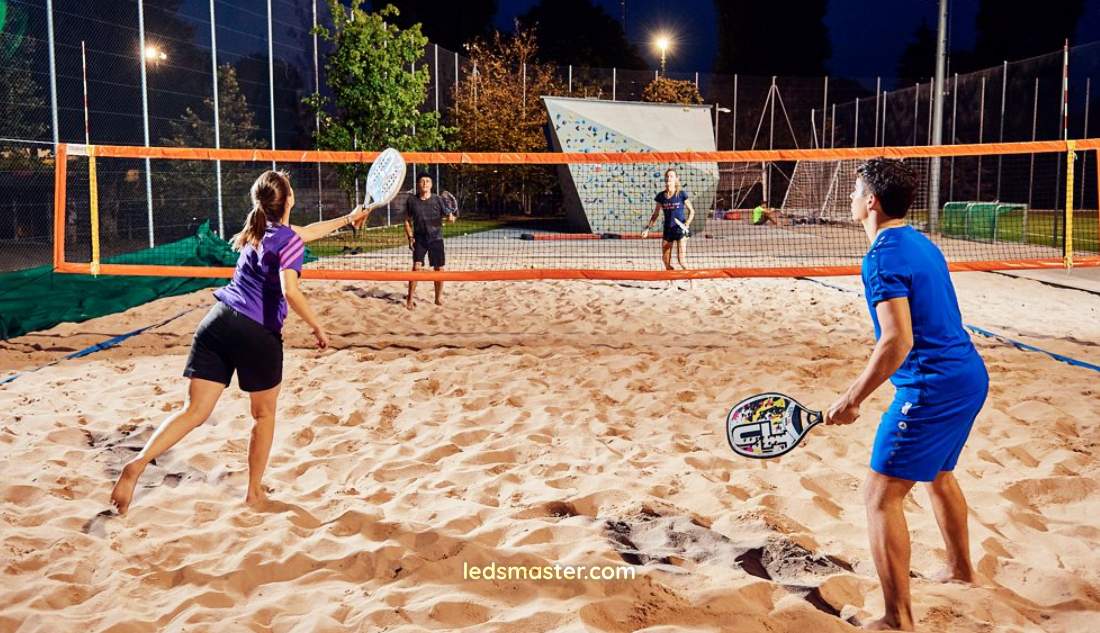Illuminate your beach sports experience with cutting-edge lighting solutions tailored for optimal performance, safety, and sustainability. Discover how our innovative LED technologies enhance visibility and create a vibrant atmosphere for all your beach sports activities.
LED lighting stands out as the optimal choice for indoor sports centers due to its lower power consumption, extended lifespan, and advanced features. By replacing traditional lighting such as metal halide, halogen, HPS, mercury vapor, and fluorescent bulbs with LED flood lights, numerous benefits are realized. These include features like IP66 waterproofing and heat resistance, making them ideal for outdoor settings like high-ceilinged or high-mast lighting at beach volleyball courts, tennis courts, and basketball sand courts.
Get your complimentary lighting design today
Table of Contents
ToggleAchieving optimal lighting for beach volleyball courts involves several factors that enhance both performance and spectator experience. The right lighting design not only illuminates the playing area but also contributes to the overall ambiance of the venue. This comprehensive guide explores the various aspects of beach volleyball court lighting, providing insights into ground lux levels, weather-resistant lighting, heat dissipation, uniformity, color temperature, flicker reduction, and the specific needs of beach tennis courts.
Adequate brightness plays a vital role in volleyball court lighting design. For recreational indoor sports centers, a brightness of approximately 75 to 150 lux is often sufficient to ensure visibility and safety during gameplay. In contrast, low-level competitions may require brightness levels ranging from 150 to 200 lux. However, high-level competitions, such as The Beach Slap or Players Beach Series, demand extraordinarily high lighting standards. These events require brightness levels ranging from 700 to 1500 lux to ensure optimal performance and visibility for both athletes and spectators.

Different competitive levels have varying lighting needs. Recreational play can operate under lower lux levels, allowing for a comfortable environment while keeping energy costs manageable. Conversely, elite competitions necessitate the brightest conditions to accommodate fast-paced action and ensure that all movements are visible. This distinction in brightness requirements highlights the need for a tailored approach to lighting design.
Lighting designers must carefully select the appropriate power and placement of LED lights to meet these diverse requirements. Each venue’s unique characteristics, including court size, surrounding environment, and audience expectations, dictate the ideal lighting solution. The careful calibration of brightness not only enhances player performance but also elevates the overall viewing experience for fans.
In addition to selecting the right lux levels, strategic placement of lighting fixtures is crucial. Proper positioning helps to minimize shadows and create an even distribution of light across the playing area. By taking into account the layout of the court and the specific demands of the sport, lighting designers can ensure that players have clear visibility throughout the game.
Selecting the right lighting solutions goes beyond mere brightness. Designers must also consider the quality, energy efficiency, and durability of the lighting fixtures. This includes choosing LED lights that offer the longevity and robustness needed for outdoor sports environments.
Several factors influence the selection of lighting systems, including budget constraints, energy efficiency goals, and aesthetic considerations. For beach sports centers, these factors can be particularly pronounced due to the outdoor setting and the potential for inclement weather. Understanding these influences allows designers to create effective solutions tailored to the venue’s needs.

The right lighting design contributes significantly to the overall atmosphere of the beach sports center. It can elevate the excitement of events and create an engaging experience for spectators. This enhancement not only benefits the players but also encourages audience participation and enjoyment.
While the technical aspects of lighting are crucial, aesthetics also play a role in design. Thoughtful lighting solutions can highlight the beauty of the beach environment and complement the venue’s architecture. This balance between functionality and visual appeal creates an inviting atmosphere for both players and spectators.
Beach volleyball courts, particularly those located outdoors, face various challenges, including sand, dust, and inclement weather. These factors can significantly impact the durability and effectiveness of lighting systems. To address these challenges, LED sports floodlights equipped with an IP66 rating provide complete dust-proofing and are designed to withstand harsh weather conditions, including heavy rainstorms and strong winds.
The IP66 rating indicates that these lights are protected against dust and can endure powerful jets of water, ensuring reliable performance regardless of environmental conditions. This level of protection is particularly important for beach sports lighting, where exposure to the elements is a constant concern.
By utilizing robust and weather-resistant fixtures, beach sports centers can maintain consistent lighting quality and minimize maintenance needs. Regular maintenance can be both time-consuming and costly, so investing in durable fixtures is a strategic decision for any sports facility.
Durability is essential for outdoor sports lighting, where fixtures are subject to the harsh effects of sun, saltwater, and moisture. Choosing high-quality materials and finishes that resist corrosion and fading contributes to the long-term reliability of the lighting systems. This investment ensures that venues can operate smoothly, reducing downtime and enhancing the overall experience.
Efficient heat dissipation is a vital consideration for indoor beach sports lighting. Accumulated heat within luminaires can lead to reduced LED lifespan and affect overall performance. To mitigate these issues, advanced heat sink designs are employed to efficiently dissipate heat without the need for cooling fans.
These passive thermal management systems utilize dense, extended fins to maximize heat transfer, ensuring that the fixtures operate at optimal temperatures. By maintaining a cooler environment for the LEDs, lighting designers can extend the lifespan of the fixtures, reduce energy consumption, and enhance overall lighting performance.
This not only translates to lower replacement costs but also contributes to the sustainability of the lighting system. The design of these heat management systems is a vital aspect of developing long-lasting and efficient lighting solutions for beach sports facilities.
Achieving uniform lighting distribution across the volleyball court is essential, especially for televised or high-profile tournaments. Uneven lighting can create shadows and distract players, impacting their performance. To ensure consistent illumination, lighting engineers utilize sophisticated software for precise photometric analysis and simulation.
Through careful planning, designers can adjust factors such as LED beam angles and placement to create a uniform lighting environment that meets or exceeds industry standards for uniformity. A uniformity ratio of 0.6 to 0.7 is often targeted, as this range significantly enhances player visibility and audience comfort.
With proper uniform lighting, athletes can better anticipate the trajectory of the ball, while spectators can enjoy a clearer view of the action. This improved visibility enhances the overall experience for everyone involved, making the event more enjoyable.
Designers may employ various techniques to achieve lighting uniformity, including adjusting the height and angle of fixtures, using reflectors to direct light effectively, and incorporating a mix of fixture types. By strategically combining these approaches, they can create a well-lit environment that meets the needs of both players and spectators.
The choice of color temperature significantly influences the atmosphere and visibility on the court. Different color temperatures create varying effects on the visual perception of players and spectators. For instance, white light, often associated with invigorating brightness, has a higher blue light content that can enhance visibility but may also lead to increased glare.
Conversely, yellow light provides a warmer, more relaxing ambiance but may affect color perception, making it harder for players to distinguish between the ball and the background. This highlights the importance of selecting an appropriate color temperature that enhances visibility without compromising comfort.
Lighting designers offer a wide range of color temperatures, from 2700K to 7500K, allowing customization based on the specific needs of the sports facility. This flexibility enables beach sports centers to create the desired atmosphere while ensuring optimal visibility for players and spectators alike. Properly selecting color temperature is a crucial step in the overall lighting design process, as it directly impacts the experience of all involved.
Testing different color temperatures in real-world conditions is essential for achieving the desired effect. By conducting trial runs with various lighting setups, designers can gather feedback from players and spectators, making adjustments to optimize both functionality and aesthetics.
In today’s digital age, capturing high-quality video footage of beach volleyball action requires smooth and continuous lighting to avoid flicker. This is particularly important when using slow-motion cameras that operate at high frame rates, such as 5000 Hz. Flickering lights can lead to distracting visual artifacts in the footage, diminishing the quality of broadcasts and recordings.
To combat this issue, advanced LED sports lights incorporate flicker-free optics that ensure seamless illumination. This technology allows for consistent light output without fluctuations, enabling high-quality video capture of intense spikes, dives, and rallies. By investing in flicker-free lighting solutions, beach sports centers can enhance their visibility not just for live audiences but also for viewers watching on screens around the world.
LED lighting technology offers numerous advantages over conventional lighting options, particularly regarding durability and longevity. With a longer lifespan and lower maintenance requirements, LED lights emerge as a cost-effective and sustainable choice for beach tennis courts and other outdoor venues.
The energy efficiency of LED lights also contributes to lower operational costs over time, allowing sports centers to allocate resources toward other areas of facility management. By investing in energy-efficient lighting systems, facilities can reduce their overall energy consumption and associated costs.
By reducing energy consumption, LED lighting solutions align with broader environmental sustainability goals, making them a preferred choice for beach sports centers committed to minimizing their ecological footprint. As awareness of environmental issues continues to grow, many facilities are prioritizing eco-friendly practices, further promoting the use of energy-efficient lighting systems.
Achieving optimal lighting for beach volleyball and tennis courts involves a meticulous balance of brightness, durability, and performance-enhancing features. From ensuring adequate lux levels tailored to different levels of play to providing robust, weather-resistant LED solutions that maintain efficiency and safety, lighting design prioritizes both player experience and environmental sustainability.